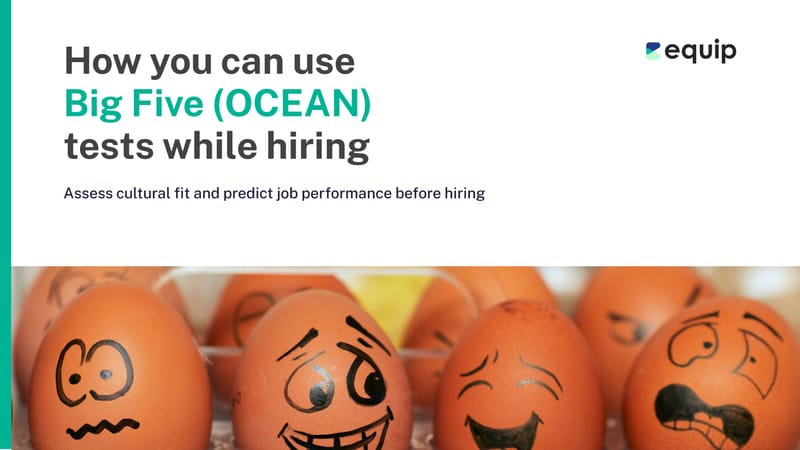
Personality tests can be an important tool for recruiters and organizational leaders to assess and predict an individual employee’s behavior, job performance, and outcomes. The Big Five (OCEAN) personality test is a common, widely-used personality test for organizations to use during the recruitment process and beyond.
Psychometric assessments can help give recruiters a broader view of an employee and help uncover core personality traits that may not be evident during interviews or pre-screening. This is important because 90% of employers say it is “very important” to find candidates who are a good cultural fit, and 98% of employers believe cultural fit is important when considering a member of staff for a management role, according to research.
Employees who may not have all of the necessary hard skills –but who fit well into the cultural makeup of an organization– are known as “personality hires” and play an invaluable role in shaping and maintaining a positive company culture.
Here’s everything you need to know about the Big Five test.
What Is the Big Five test?
The Big Five Personality Test – sometimes called the Five-Factor Model (FFM) – is a personality test designed to measure the five main dimensions of an individual’s personality – openness, conscientiousness, extraversion, agreeableness, and neuroticism.
It operates on a framework that these five characteristics can account for individual differences in personality, so a comprehensive assessment of the five traits can help hiring managers get a broad understanding of a candidate’s personality.
It’s a psychometric test that can be utilized to predict many aspects of an employee’s behavior, their job performance, and interpersonal skills.
Overview of the Five Factors (OCEAN)

Here’s an overview of the “Big Five” factors and their characteristics:
- Openness to Experience: This is about how open an employee is to new experiences and new opportunities. It’s characterized by curiosity and creativity.
- Conscientiousness: This measures how organized and goal-oriented an employee is, characterized by self-discipline and dependability.
- Extraversion: As expected, this measures how sociable an employee is, including their assertiveness and enthusiasm around others.
- Agreeableness: This measures an employee’s interpersonal skills, like cooperation and altruism.
- Neuroticism: Evaluates emotional stability, including potential roadblocks like anxiety.
When to use the Big Five Personality test
The Big Five personality test can be used at multiple stages of an employee’s life cycle. Although it’s typically used during the candidate screening and recruitment process, that’s not the only time it can be used.
During the recruitment phase, the Big Five personality traits test can help assess for culture fit within an organization. The results of the personality test can determine if their traits align with the larger organization and its values.
During team-building exercises, the Big Five personality test can help assess compatibility within a team. Especially for teams that are newly formed or have new members, it can help give a more comprehensive understanding of how team members will be able to collaborate. It also gives managers insights into how to better lead their team and individual employees.
During learning and development, the Big Five test can identify strengths and weaknesses based on the OCEAN traits, which can help identify areas for personal and professional development to help create a more targeted and personalized development plan.
How the Big Five Personality test compares to others
The Big Five or OCEAN test is just one of many types of personality tests that can be used in organizations, and the one you choose to implement into your strategy will depend on workforce and organizational needs.
| Big Five/ OCEAN | 16 Personality Factors | MBTI | |
|---|---|---|---|
| Core Assessment Areas | Openness, conscientiousness, extraversion, agreeableness, neuroticism | 16 primary factors, including warmth, stability, and vigilance | Extraversion-Introversion, Sensing-Intuition, Thinking-Feeling, Judging-Perceiving |
| Organizational Use | Recruiting, hiring, team-building | Employee development | Career counseling, team-building |
| Focus | Broad personality | Detailed personality traits | Personality preferences |
Test providers
There are many providers that can administer the OCEAN personality test. Although specific details can vary, the test is usually self-administered and scored through an automated system.
If you’re looking for a provider of the Big Five Personality or OCEAN test, here are some resources:
Try a free demo psychometric test from Equip here:
Considerations for using the test
Deciding to use the Big Five personality test is one piece of the puzzle, but it can be equally important to ensure that you’re using best practices in administering the test to optimize results and ensure accuracy in scoring and interpretation.
Here are some best practices for using the Big Five personality test:
- Don’t take answers at face value; compare and contrast them with other personality interpretations to ensure you have a full view of a candidate
- Avoid bias by choosing a reputable administrator for the test and keeping in mind nuances about neurodivergence or other differences.
- Provide accommodations for those who need it and give clear, detailed instructions on the purpose and administration for the test.
Related: Can DISC Assessments Really Help Us Understand People Better?
